
13 Of The Deadliest Animals in Florida
While Florida draws millions of tourists annually with its gorgeously warm weather, beautiful sandy beaches, and vibrant theme parks, not everything is rosy and cozy about the Sunshine State. Beneath its sandy shores, within its emerald waters, and amidst its dense jungle lurk deadly critters and climbers capable of inflicting serious harm and, worst case scenario, causing death. From venomous snakes slithering in the undergrowth and aggressive gators hiding under murky waters to ferocious felines wandering the Everglades, Florida has a not-so-friendly side visitors would like to avoid.
This article sheds light on some of the deadliest animals in Florida that visitors and lifelong Floridians would be wise to give a wide berth. By learning to identify these perilous predators and knowing what to do to avoid confrontations, you can safely enjoy the diversity of Florida’s landscapes without fuss. The next time you hit the trails or waterways, keep an eye out for these unexpectedly lethal locals.
Bull Shark
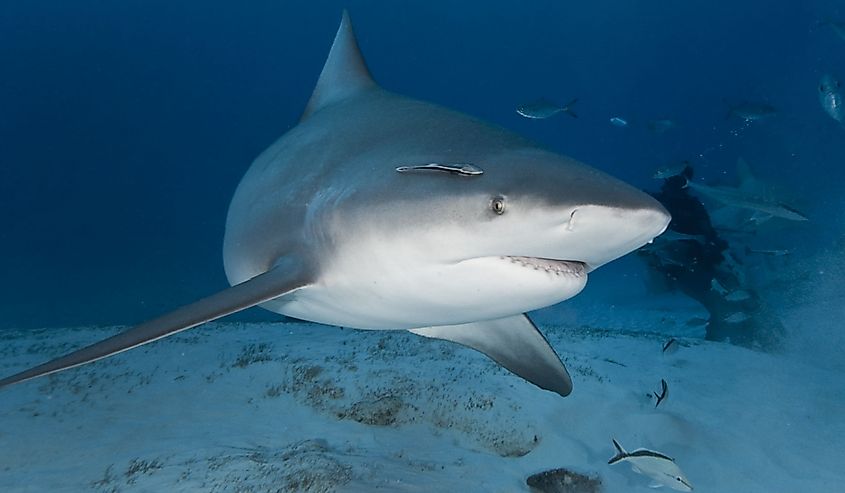
The bull shark (Carcharhinus leucas), fierce, territorial, and extremely dangerous, roams the coast of Florida, choosing to dwell in the warm and shallow offshore waters of the Gulf and Atlantic Ocean. Bull sharks grow to an average of ten to eleven feet, with a lifespan of about 30 years. They are distinguished from other sharks by their high width-to-length ratio, which gives them a stout appearance. They also have a darker coloration on the top with a lighter underbelly.
Encounters with humans are quite common in Florida’s shallow waters. Bull sharks are responsible for a large share of unprovoked shark attacks. They have a lethal bite with numerous razor-sharp teeth that can cause fatal damage. Their aggressive and territorial tendency makes them one of the most dangerous animals in Florida’s waters. Interestingly, the species is the inspiration for the movie “Jaws.”
Cottonmouth Snake
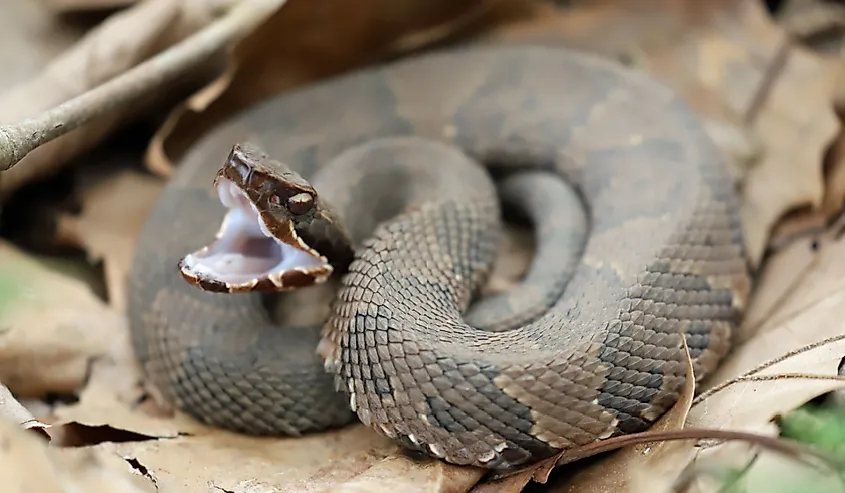
The cottonmouth (Agkistrodon piscivorus) is a dangerous semi-aquatic pit viper occurring throughout the Southeast United States. In Florida, they occupy inland watersheds, including lakes, streams, marshes, swamps, roadside ditches, and swamps, but they can occasionally stray from the water. Cottonmouths range between 20 and 48 inches long, with varying color shades, from dark brown and olive green to jet-black. They also have a conspicuous dark line passing through the eye, contrasting with the white above and below it.
These snakes are more active during the day than at night, although they stay out late in hotter months. This increases the likelihood of encounters with humans. Their bites are painful, and the venom can be fatal if left untreated. Victims have a one-hour window to seek medical care. The poison is potent enough to paralyze you, with victims easily drowning when bitten underwater.
Florida Panther
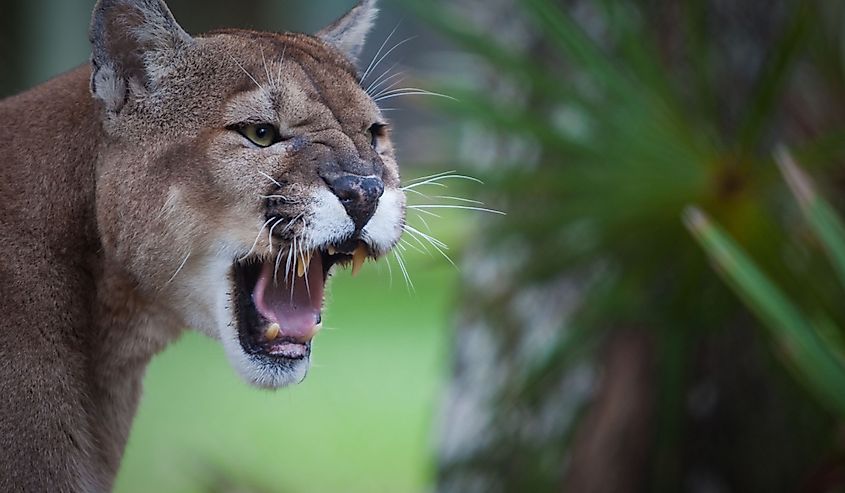
Florida panthers (Puma concolor coryi) are an endangered species mainly occupying the southern regions of Florida. They belong to the mountain lion family and choose pinelands, swamp forests, and hardwood hammocks as their habitat. These natural-born predators can weigh up to 250 pounds when fully matured, posing a serious threat to humans. They have sharp fangs, powerful claws, and a muscular body, all the tools needed to subdue a grown man in the event of an encounter. Panthers are solitary creatures that become active at night, hunting in the cover of dark. This means you should be wary of them when camping in the Florida wilderness.
Most Florida panther attacks result from people trespassing into their habitat. Their territorial nature and predatory instincts compel them to launch an attack on trespassers. Although they don’t have natural predators, except for maybe crocodiles, hunters' persecution has endangered them.
Burmese Python
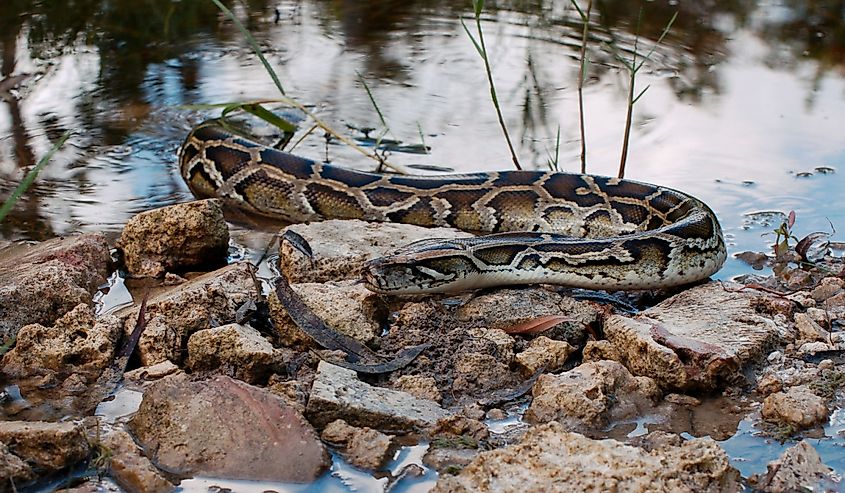
The Burmese python (Python bivittatus) is among the largest snakes in the world. It is an invasive species in Florida, native to Southeast Asia. These massive beasts can reach 18 feet in length and pose a great threat to adventurers in Florida’s backcountry. They can be found in the sprawling Everglades in southern Florida, where they are responsible for terrorizing native species, capturing their habitats, and ultimately killing them. Burmese pythons, although non-venomous, have a muscular and powerful body that wraps around the prey and squeezes them to death.
Although they are not a threat to humans, they have a painful bite that can leave you in excruciating pain. However, they have the potential to kill and even consume a small child. There is a report of a Burmese python killing and swallowing a 5-foot alligator.
Pygmy Rattlesnake
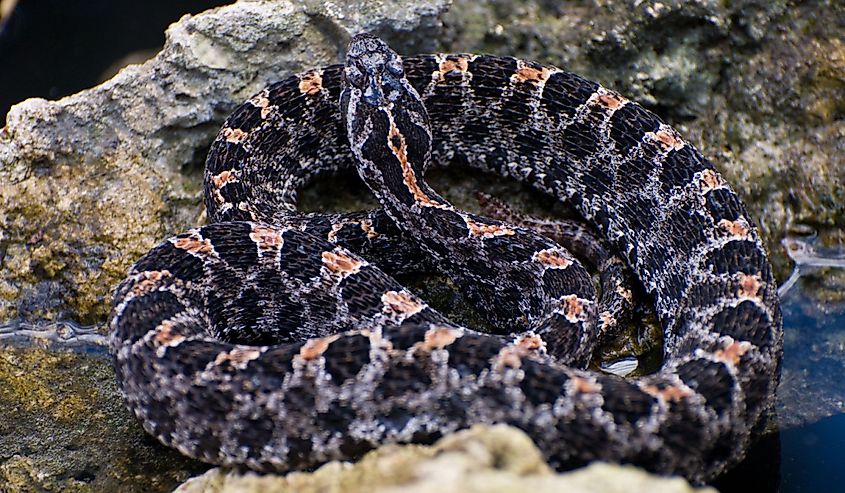
Pygmy rattlesnakes (Sistrurus miliarius) are one of the smallest species in the rattlesnake family. They are native to America, most occurring in the southeastern states, from the Florida Keys to Missouri, southern North Carolina, and southern Kentucky. They inhabit upland forests and wetlands like marshes, swamps, creeks, and pons. Although considered venomous, the poison is not as potent as in other species in its family. These slithery species have short but stout bodies with a series of circular marks from the center to the back.
They have a white underbelly and a dark line passing through each eye, with adults weighing as much as 5.4 ounces. Pygmy rattlesnakes have a venomous bite that can be dangerous to humans, especially little children and pets. The consequences are more severe in kids as the venom gets to them faster.
Florida Black Bear
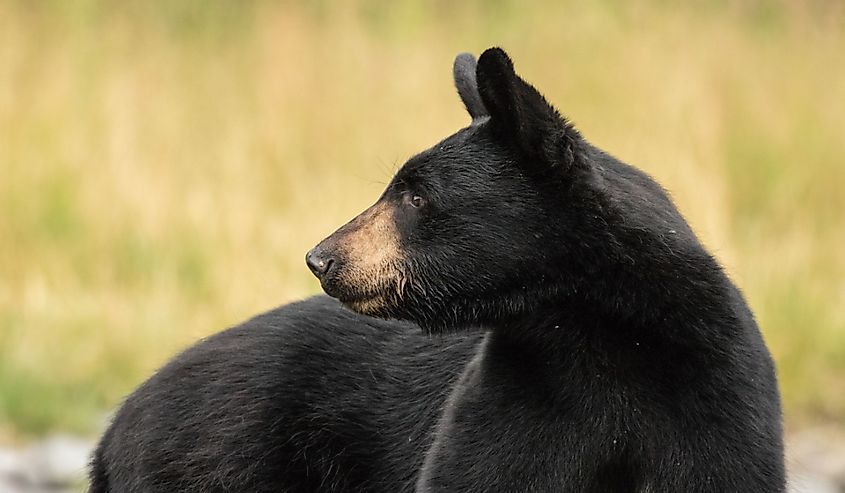
While they are not as big as their grizzly counterparts, black bears (Ursus americanus) will surprise you with their strength. These omnivorous beasts roam the Florida scrublands and wetlands, with a history of straying into human settlements. In their search for food, they are often found fiddling with the trash can and bird feeder. As the largest mammals in the state, they are dangerous antagonist to adventurers. Adults can weigh up to 600 pounds, and long claws and strong fangs give them the tools they need to hunt down prey.
Despite this, black bears are shy among humans and would rather walk away in an encounter, but they will also attack when feeling threatened. Most conflicts arise from humans encroaching into their habitat. This is especially true for campers and hikers on the trail. Luckily, giving black bears a safe distance will avert any nasty confrontations.
American Alligator
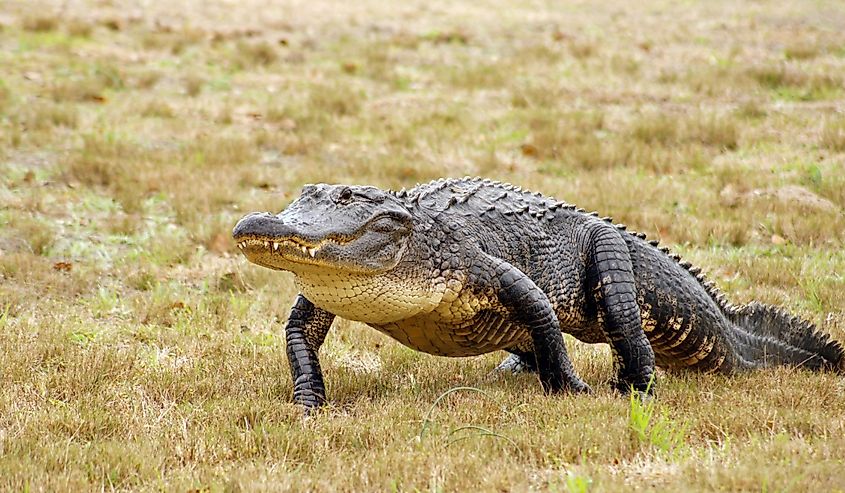
American alligators (Alligator mississippiensis) are related to crocodiles, although they don’t belong to the same family. They are distinguished by their wider and rounded snout as opposed to the crocodile’s longer and pointed snout. Alligators inhabit the swampy terrains in Florida, choosing to hide under the murky waters with their eyes and snouts popping out of the water. Their diet mainly includes fish, birds, and even mammals. These apex predators sit atop the food chain and adults can grow up to 15 feet long, weighing about 1,000 pounds.
Alligators are powerful creatures with sharp interlocking teeth and a muscular, powerful tail. A bite can easily break bones and once they latch onto prey, they pull it under the water to suffocate it. While they may not be harmful to humans, alligators can be aggressive when you invade their territory.
Brown Recluse Spider
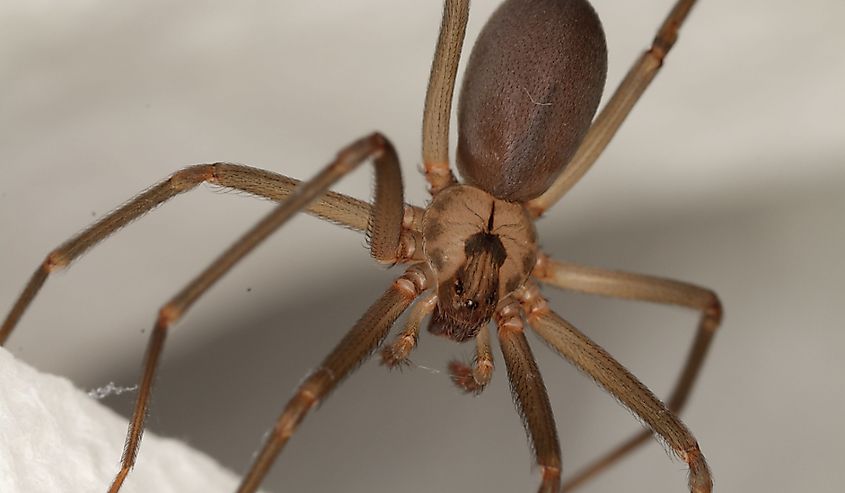
Brown recluse spiders (Loxosceles reclusa) are sometimes referred to as violin or fiddleback spiders. They are among the venomous spider species in the state, and their necrotic venom makes them one of the deadliest animals in Florida. Recluse spiders are tiny crawlers that reach about 6 to 10mm long and sport shades of grayish brown to yellowish, with a violin-like head and long legs. They look like common house spiders and establish nests in homes, making them an instant danger to humans. They have a venomous bite that causes symptoms like fever, nausea, and necrosis.
A bite will require immediate medical attention, and delays only serve to compound the problem. As a precaution, you should be careful around spider webs in your home and, if possible, call an exterminator to rid you of any infestations.
Southern Black Widow
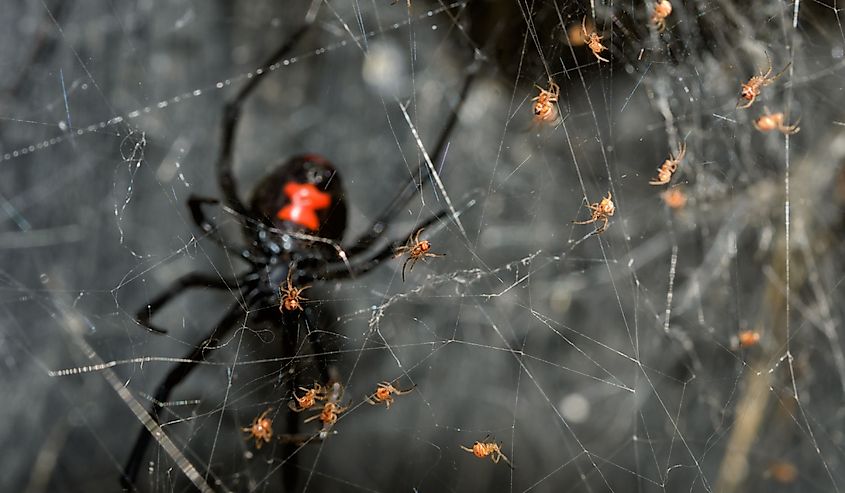
The black widow (Lactrodectus mactans) is another poisonous spider species found in Florida. They occur in the areas west of Tallahassee, building nests under rocks, forests, tree stumps, and any dark and undisturbed spaces. Black widows have a jet-black body with distinct red markings on the abdomen. Females are usually larger than males and can grow to a length of 19mm. They deliver a painful sting accompanied by a dangerous venom that causes severe discomfort, leaving a swell around the bite site. Lingering symptoms include muscle spasms, cramps, and stomach sickness.
If bitten, you should rush to the emergency room and get immediate medical care. While most bites rarely end in fatalities if handled timely, some symptoms tend to persist longer than usual, which means you should go back to the doctor.
Boxed Jellyfish
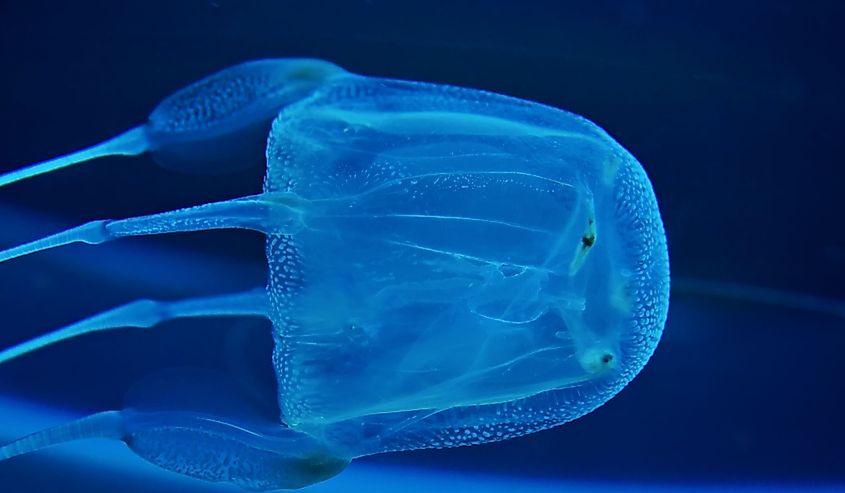
In Florida, the boxed jellyfish (Chironex fleckeri) kills more people than sharks, making it one of the biggest threats in the state’s beautiful waters. These interesting creatures are made out of 95% water but have no brains, respiratory, or excretory systems. They have a cube-like shape with a transparent or pale blue color and numerous stinging tentacles attached around the upper body. Jellyfish inhabit the tropical shores of the state, which are rich in different types of aquatic wildlife.
They are among the deadliest creatures in the sea and pack a lethal known to stop the heart. Their dangling tentacles are full of stings that inject venom into the system. This attacks the nervous system, eventually paralyzing the heart. When stung at sea, some victims fail to make it back to shore before the poison does its damage.
Eastern Diamondback Rattlesnake
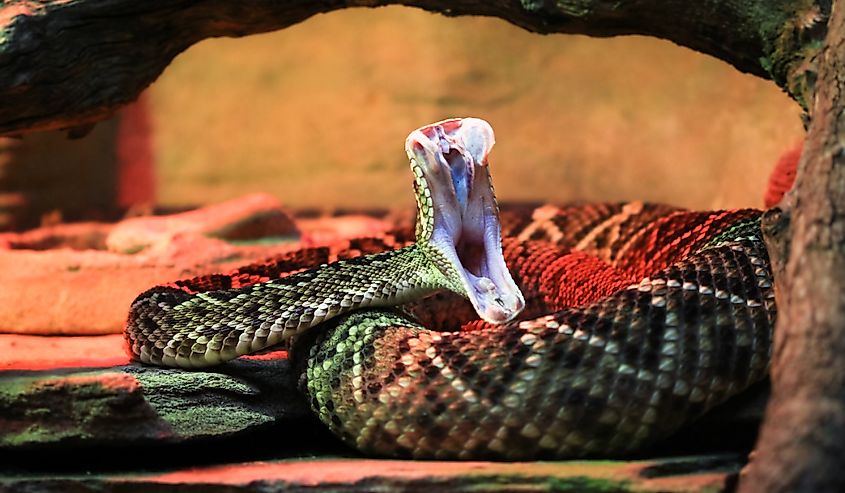
Eastern diamondback rattlesnakes (Crotalus adamanteus) are robust creatures made up of muscle and scales. They are among the heaviest venomous snakes worldwide and are considered one of the most dangerous in North America. These snakes typically measure 3 to 6 feet in length, with some adults reaching up to 8 feet and weighing around 10 pounds. They mainly inhabit long pine savannas but can also be found in pine flatwoods and wiregrass regions. They are good swimmers and are often seen on barrier islands around the state. Like other rattlesnakes, they have a rattle on their tails, which they shake to warn potential threats. If ignored, they can deliver a painful bite that injects hemotoxin, which damages and destroys red blood cells. The venom has a mortality rate of approximately 10-20%.
Fire Ant
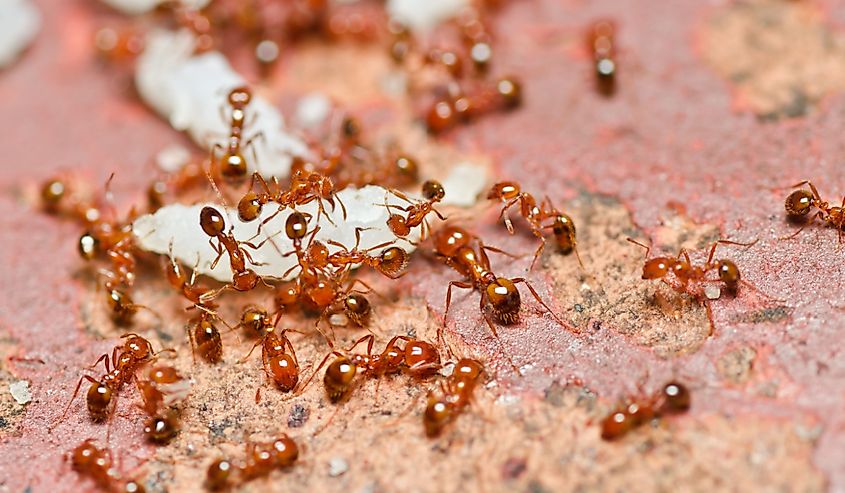
Florida is home to many ant species, but the red imported fire ant (Solenopsis invicta) is especially notable for its aggression and problematic nature. These fire ants, which range in color from reddish-brown to bright crimson, often build mounds in open areas such as yards, parks, and roadsides. Their stings are sharp and burning, causing significant pain. Colonies can contain thousands of ants, including workers, soldiers, and queens. It's advisable to avoid their mounds near homes or structures. Despite being a health risk and nuisance, fire ants play a role in the ecosystem by preying on other insect pests. Their numbers have surged across Florida and the entire country, now covering over 200 million acres in the United States.
Kissing Bug
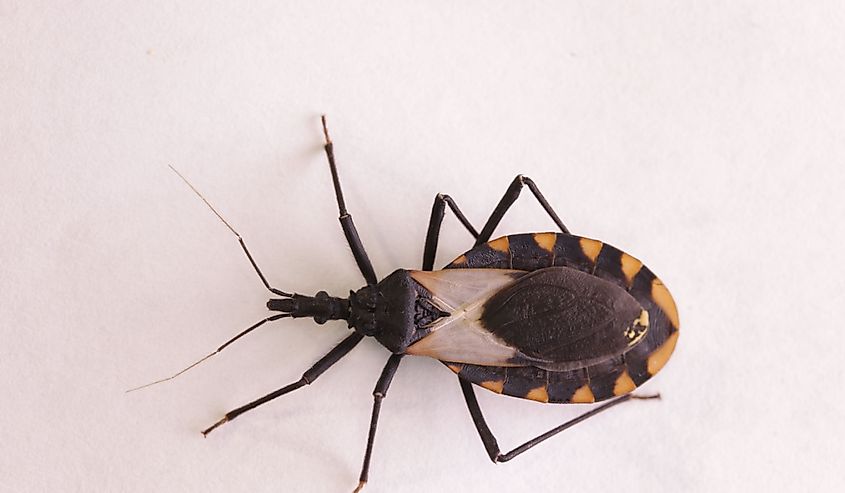
The kissing bug (Triatominae sanguisuga) is found throughout Central and South America but has recently established populations in parts of the southern United States, including regions of Florida. As their name implies, these nocturnal insects target areas around the face to deliver their parasitic bite, often around the lips. Kissing bugs carry and transmit the parasite Trypanosoma cruzi, which causes potentially life-threatening Chagas disease. Left untreated, this infection can lead to cardiac or digestive complications in humans.
Much like mosquitoes and other small insects, kissing bugs are commonly found around the outskirts of homes and buildings, often entering through cracks and crevices at night in search of a blood meal. Their presence in Florida is of increasing concern, as the parasites they carry can establish long-term, latent infections in residents.
Winding Up
Although Florida seems mild and tropical on the surface, it hosts some surprisingly dangerous creatures beneath the palm trees and in its waters. Venomous snakes, spiders, insects, and aggressive predators all pose serious health hazards to both residents and visitors. You can greatly lower the chances of conflict or injury by learning about their habitats, behaviors, and knowing what to do if you encounter the deadliest animals in Florida. Always stay aware of your surroundings in wilderness areas, avoid disturbing or provoking wildlife when possible, and seek prompt medical attention if bitten or stung.











